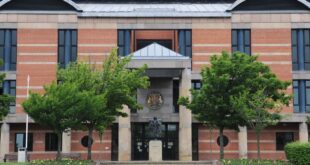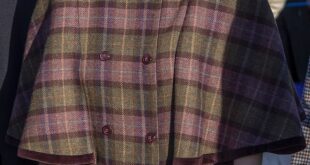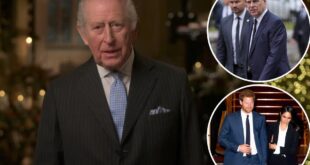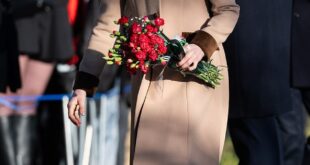Tina Brown’s new book, The Palace Papers: Inside the House of Windsor, the Truth and the Turmoil is a follow-up to her well-received 2007 The Diana Chronicles and focuses on the period after the Princess’s death.Handout
In July, 1997, Diana, Princess of Wales, invited Tina Brown, then-editor of The New Yorker, and Anna Wintour, the editor of Vogue, to lunch. The Princess was in New York for the charity auction of her dresses at Christie’s and later sat down with the journalists, speaking about the loneliness and pain she experienced in her marriage to Prince Charles. She then quickly pivoted the conversation to discussing how she wanted to leverage her royal celebrity for her humanitarian campaigns and how she planned to put out a documentary every two years on these causes. “In her later years, Diana had quickly learned the media game and she was very adept at it,” says Brown from New York. “She was always making sure to put her vision out to chosen members of the press and I guess in inviting Anna and I, it was two birds with one stone. Even though I had met the Princess on multiple occasions from when I was the editor at Tatler, this particular memory is etched in my mind because six weeks later, she was dead.”
Brown’s new book, The Palace Papers: Inside the House of Windsor, the Truth and the Turmoil – a follow-up to her well-received 2007 The Diana Chronicles – focuses on the period after the Princess’s death. “Diana has a sort of astral presence in the book as someone whose influence is still profound and whose memory, power, popularity and fascination permeates the Royal Family and the royal legacy as they try to get past her and beyond her,” she says. “As the book progresses, Diana’s influence recedes in the activities of the royals, but in her sons’ minds and emotions she stays ever-present.”
This August will mark 25 years since the night of that fateful car accident in Paris, and we’re hearing more about Diana from Princes William and Harry than ever, Brown says. “There was a long period where the boys never spoke about their mother; it was around the 2007 anniversary that they began to talk about her. William is more judicious in the amount that he says, but Harry has spoken greatly about the tragedy and its impact on his own life.”
Brown says that the pendulum has really swung in the past seven years around the narrative of seeing Diana only in terms of her victimhood in the last days of her life. “The media tends to stick with the victim story because it’s a much simpler one,” she assesses, “but I think that Diana was a much more interesting character than that.” Brown says the complicated version is that Diana had many lovers – a couple of them married – in the last years of her life, and because she believed that she was being spied on by the royal apparatus, she was adamantly against having royal protection. “She felt inhibited by royal security and thought that having it would make them eager to inform the Palace of her comings and goings. But the truth is she wasn’t being spied on at all – really she was made paranoid by the British press.”
That decision to deny royal protection would be Diana’s most fundamental and tragic mistake, Brown says. “Royal security are trained to look after their principal and keep the paparazzi at bay. If Diana had had royal security that night, there is absolutely no way she would have been allowed to get into the car because, unlike private protection, royal security is not answerable to the principal – they report to Scotland Yard. If the Princess had agreed to royal security, she would not be dead.”
Brown believes that the path to Diana’s tragic fate began with the fairytale wedding. “I’m a huge fan of Diana – I wrote a whole book about her – but I see her as a person who was essentially gaslighted into the Royal Family. All of Prince Charles’ friends as well as the Royal Family knew he was in love with and emotionally committed to someone else,” she says. “While I do believe that Charles was fond of Diana in the beginning and tried to tell himself that he loved her, I feel that their getting married was the original sin of Diana’s predicament.”
The book brings these and a myriad of other profound perspectives to the surface, giving history, context and insight from more than 130 insider sources. “It’s about the circles of trust you build in the course of reporting,” Brown says. “So many of the Palace sources who might not have been co-operating at the beginning of the process came to understand that I was trying to do something deeper, and with a sense of history. Many of these Palace people were initially reluctant because they had been burned by exposé scams and tabloids, so it took time to win their trust.” Brown says that some of her sources were from the Diana era and others came on board as they began to understand that she was a reliable and truth-seeking journalist.
The book even tells the story behind Brown’s own July, 2010, encounter with the infamous and former friend of the disgraced Prince Andrew: late financier Jeffrey Epstein. “I was at The Daily Beast at the time [the digital news site she founded in 2008] and we were the first to take on the story of Epstein’s lack of punishment for crimes that were far greater than those he was punished for,” she says. “To this day I don’t know how, but he found his way past reception and was waiting for me in my office. He told me there would be consequences if I ran the story. It was very unnerving.” Over the next eight months, Brown published six exposés on Epstein regardless, expecting legal action – but there was none. “Instead he went on a sort of counter public-relations campaign about all of his philanthropic efforts.”
Some of the research for The Palace Papers caught Brown off-guard herself. “I was more empathetic towards Prince Harry than I expected to be when I did a deep dive into what he experienced with the British press as a teenager,” she says. “He couldn’t make one adolescent slip without it being splashed across the tabloids as some out-of-control trouble maker. He had a very rough time of it.”
Brown says that the other thing she had a deeper understanding of by the time she finished reporting was what it’s like to live with the idea of “duty.” “It’s really onerous to live that life. It’s like a secular version of taking the veil,” she says. “If you’re going to join the Royal Family, you have to understand that that is going to have to be the price you pay and you have to do so for the rest of your life. Kate has taken that veil, so to speak. Camilla had a whole life before it, but since she has been married to Charles, she has really buckled down and done it. But there are others that just simply found that life impossible. And I’m sympathetic with that, too.”
The book gives in-depth accounts of Camilla Parker Bowles’s cautious but active ascension from abhorred mistress to emerging Queen Consort, as well as Catherine the Duchess of Cambridge’s long and winding courtship with Prince William. Brown says it’s imperative to understand that both queens-in-the-making benefited from having guarded, tight-knit families. “Camilla’s family – the Shands – kept her confidence and stood behind her,” she says. “I think the same can be said of Kate’s family. They were very elegant in their discretion and prudence.” Brown says that Diana couldn’t claim this kind of unified, grounding support system from the “tempestuous Spencers” and neither can Meghan, the Duchess of Sussex, from her own family. “I felt very sorry for her for that.”
“Never again” is an echoing refrain throughout the book, and refers to the Queen’s sentiment that no one again would destabilize the monarchy as Diana did. “But that is exactly what happened,” Brown says. “Harry married Meghan Markle, who became a huge power centre very fast, because of her power of celebrity. Then the explosive interview they did with Oprah Winfrey last year was like a replay of the 1995 Panorama interview the Princess did with Martin Bashir,” she says. “Even Harry and Meghan’s entertainment deals sound a lot like the media plans Diana shared with Anna and I over lunch all those years ago, except Diana’s weren’t for profit. She was always ahead of the curve and her influence on her family continues.”
Expand your mind and build your reading list with the Books newsletter. Sign up today.
Source link



